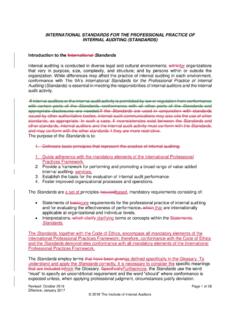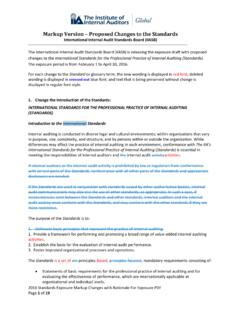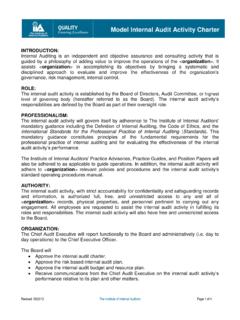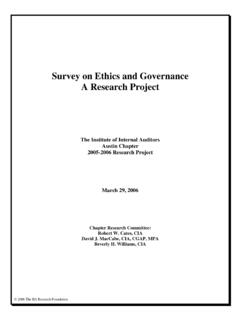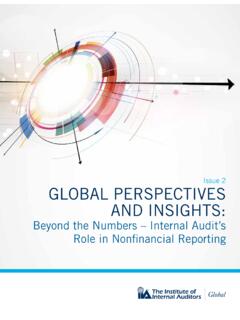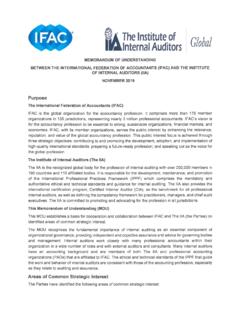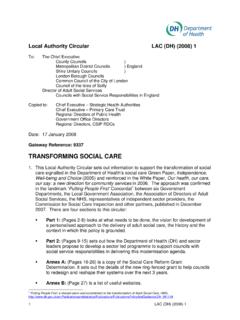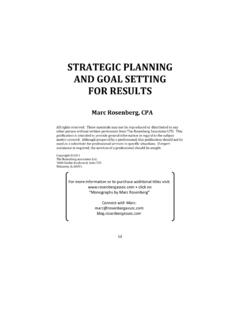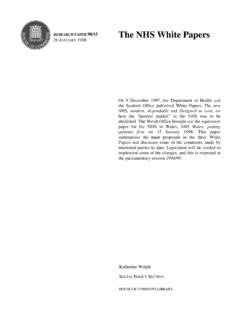Transcription of GLOBAL PERSPECTIVES AND INSIGHTS
1 GLOBAL PERSPECTIVES : Artificial Intelligence III GLOBAL PERSPECTIVES AND INSIGHTS The IIA s Artificial Intelligence Auditing Framework Practical Applications, Part B Special Edition GLOBAL PERSPECTIVES : Artificial Intelligence III Table of Contents The IIA s AI Auditing Framework .. 1 The Human Factor .. 2 Ethics Algorithm Bias Meaning Making The Black Box .. 3 Governance .. 4 Measuring Performance .. 4 Closing Thoughts .. 5 Advisory Council Nur Hayati Baharuddin, CIA, CCSA, CFSA, CGAP, CRMA Member of IIA Malaysia Lesedi Lesetedi, CIA, QIAL African Federation IIA Hans Nieuwlands, CIA, CCSA,CGAP IIA Netherlands Karem Obeid, CIA, CCSA, CRMA Member of IIA United ArabEmirates Carolyn Saint, CIA, CRMA, CPA IIA North America Ana Cristina Zambrano Preciado, CIA, CCSA, CRMA IIA Colombia Previous Issues To access previous issues of GLOBAL PERSPECTIVES and INSIGHTS , visit Reader Feedback Send questions or comments to GLOBAL PERSPECTIVES : Artificial Intelligence III Introduction Picture it.
2 A robot or least its brain before an ethics or investigative committee. It could happen. According to The Guardian, academics argue that as robots start to enter public spaces, and work alongside humans, the need for safety measures has become more pressing. Scientists are attempting to make a case for robots to be fitted with an ethical black box to keep track of their decisions, and enable them to explain yes, explain their actions when accidents happen. Professors at Oxford University argue that robotics firms should follow the examples and regulations set by the aviation industry, which include bringing in the black boxes and cockpit voice recorders to investigate plane crashes, ensuring that crucial safety lessons are learned after such tragic events. Installed in a robot, an ethical black box would record the robot s decisions, its basis for making them, its movements, and information from sensors such as cameras, microphones, and rangefinders.
3 These actions come in the wake of recent incidents, such as when Steve, a Knightscope K5 patrol robot, fell down steps and plunged into a fountain while on duty, or when another K5 robot became involved in a carpark altercation with a 41-year-old man while patrolling the streets of Mountain View, Calif., or the robotic unit accused of running over a 16-month-old child in a Stanford shopping center. All injuries of humans involved were minor. There are hundreds of reports on the ethics of artificial intelligence; however, most are lightweight and full of platitudes about putting people first , writes Scott Rosenberg, editor of Backchannel. Rosenberg extracts from recently released reports from New York University s AI Now Institute about a tech industry attempting to reshape society along AI lines without any guarantee of reliable and fair results.
4 One report concludes that efforts to hold AI to ethical standards to date, have been a flop, and that new ethical frameworks for AI need to move beyond individual responsibility to hold powerful industrial, governmental, and military interests accountable as they design and employ AI. In authors opinions, AI systems are being introduced in various and vulnerable areas, such as policing, education, healthcare, and other environments, where the misfiring of an algorithm could ruin a life. The IIA s AI Auditing Framework As explained in Artificial Intelligence Considerations for the Profession of Internal Auditing, internal audit s role in AI is to help an organization evaluate, understand, and communicate the degree to which artificial intelligence will have an effect (negative or positive) on the organization s ability to create value in the short, medium, or long term.
5 Note: This is the third report in a three-part series. For more information, see Artificial Intelligence Considerations for the Profession of Internal Auditing and The IIA's Artificial Intelligence Auditing Framework: Practical Applications Part A. GLOBAL PERSPECTIVES : Artificial Intelligence III To help internal audit fulfill this role, internal auditors can leverage The IIA s AI Auditing Framework in providing AI-related advisory, assurance, or blended advisory/assurance services as appropriate to the organization. The Framework is comprised of three overarching components AI Strategy, Governance, and the Human Factor and seven elements: Cyber Resilience; AI Competencies; Data Quality; Data Architecture & Infrastructure; Measuring Performance; Ethics; and The Black Box.
6 Internal audit should consider numerous engagement or control objectives, and activities or procedures, in implementing the Framework and providing advisory, assurance, or blended advisory/assurance internal audit services related to the organization s AI activities. Relevant objectives and activities or procedures that address the Strategy (Cyber Resilience and AI Competencies elements) and Governance (Data Architecture & Infrastructure, and Data Quality elements) of the Framework were provided in The IIA s Artificial Intelligence Auditing Framework: Practical Applications Part A. This document provides relevant objectives and activities or procedures that address the Human Factor (Ethics and The Black Box elements) and Governance (Measuring Performance element). The Human Factor The Human Factor component, which includes Ethics and The Black Box elements, addresses the risk of human error compromising the ability of AI to deliver the expected results.
7 Ethics Algorithms developed by humans that include human error and biases (both intentional and unintentional) will impact the performance of the algorithm. The human factor component considers whether: The risk of unintended human biases factored into AI design is identified and managed. AI has been effectively tested to ensure that results reflect the original objective. AI technologies can be transparent given the complexity involved. AI output is being used legally, ethically, and responsibly. Algorithm Bias According to a recent McKinsey & Company report, companies are quick to apply machine learning to business decision-making. The programs set complex algorithms to work on large, frequently refreshed data sets. However, algorithmic bias is risky business, because it can compromise the very purpose of machine learning if overlooked, and left unchecked (see Controlling machine-learning algorithms and their biases).
8 GLOBAL PERSPECTIVES : Artificial Intelligence III For example, in credit scoring, the customer with a long history of maintaining loans without delinquency or default is generally determined as low risk. However, what may be unseen is that the mortgages of this customer have been maintained and supported by substantial tax benefits that are set to expire. A spike in defaults may be in the offing, unaccounted for in the statistical risk model of the lending institution. With access to the right data and guidance by subject matter experts, predictive machine-learning models could find the hidden patterns in the data and correct for such spikes. Even more, outside of business decisions, algorithmic bias can cause errors that could spark some real problems and unrest among citizens.
9 For example, Google s Photos service and others services like it are used to identify people , objects, and scenes, but can go terribly wrong, such as when a camera missed the mark on racial sensitivity, or when a software used for risk assessments to predict future criminals showed bias. Meaning Making There are limits to what machines can do, and people must be able to make sense of AI outputs. As described in a report by McKinsey & Company, Meaning making in the AI era starts with an appreciation of what machines can and cannot do. It may be possible, for example, for a machine to make certain kinds of diagnoses more accurately than a person can. But it will be up to nurses, doctors, and therapists to help patients understand the implications and manage the consequences.
10 It s the difference between knowledge and meaning. According to the report, hard skills such as coding, analytics, and data science are critical to AI, but so are soft skills such as collaboration, empathy, and meaning making (see McKinsey Quarterly pp. 56-61). The Black Box According to the Merriam-Webster online dictionary, a black box is a usually complicated electronic device whose internal mechanism is usually hidden from or mysterious to the user; broadly: anything that has mysterious or unknown internal functions or mechanisms. As organizations advance to implementing Type III and Type IV AI technologies utilizing machines or platforms that can learn on their own or communicate with each other how the algorithms are operating becomes less transparent or understandable.
